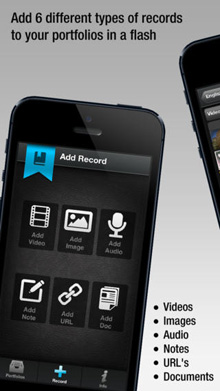
Teachers juggle so many important jobs in the classroom. They play the role of mentor, mediator, and facilitator. Often, they take on the job of confidante, parent, entertainer, and so much more. But above all else, teachers are meant to ensure student growth and this growth is expected to be documented and demonstrated through student work.
In recent years, digital technologies have been flooding into the classroom environment and altering everything imaginable, even to the most basic of classroom procedures. Keeping portfolios of student work is by no means a new idea. My own memories of school include construction paper folders tucked away in a corner of the classroom, bursting with homework papers and art projects. As time and technology have progressed, student portfolios have begun to evolve into something a little more sophisticated—and a lot more convenient.
As student work progressively includes more media-based formats, it makes sense that educators should find ways to electronically curate these examples of learning. Aside from being able to store student work in its original form, digital portfolios have the advantage of taking up less physical space and can be easily shared with parents and colleagues, as well as giving the student the ability to safely keep their work as long as they may choose. And let's face it, creating and storing an audio recording that demonstrates fluency or uploading and sharing a video a student created as a book report is a lot more impressive than a folder full of worksheets and test papers.
There are many options for digital portfolios. Student blogs, Google Drive, and wikis are all possibilities, depending on the needs of the student and teacher and the technology available. In addition, several mobile apps have been developed offering some advantages over these website-based artifact storage options.
Three Ring allows teachers to organize artifacts by student, class, or keyword tag. Photos, videos, audio recordings, and text notes can all be added and stored within the app with no data limit. Notes can also be added to media artifacts to record the purpose of a project, a performance assessment, the standard addressed, or anything else the teacher or student wishes to document. Portfolios are not only accessible within the app, but also online, and sharing with parents is simple. The app is designed to be used by both students and teachers, which is a nice feature.
School Binder can be used by either teachers or students. For teachers, a tab can be created for each student and artifacts can easily be organized and stored. For students, the app can function as an organizer, with a built-in calendar and note-taking feature, or it can be used as a traditional portfolio to save presentations, photos, and documents. The app has sharing options as well.
Teacher's Wire is designed for teacher use only. Teachers can organize students into classes and document student work via notes and photos, though other media does not appear to be supported at this time. This app also provides a place to store contact information for each student, as well as grades and behavior notes. This information can be relayed to parents via email. The grade book and behavior options make this a nice multi-purpose app for teachers.
Easy Portfolio is perhaps the most impressive and well-executed of the portfolio apps currently available. In addition to being able to upload audio recordings, photos, videos, documents, and notes, live urls can be added to link to outside sources, which would be extremely useful for student blogs and other online projects that are difficult to document within an app. Student work is shared via email, or entire portfolios can be exported to Dropbox or Google Drive. This is an excellent feature for allowing students to keep a copy of their own work. The developers of Easy Portfolio appear to be continually working on more features, so this looks like an app that will stand the test of time.
As teachers and students increasingly utilize technology to demonstrate learning in the classroom, student portfolios need to keep pace and evolve as well. These apps allow both teachers and students to document and share the incredible growth that is taking place in digital format, and give students, parents, and teachers the ability to save these artifacts for years to come.
 Lindsey Fuller is a sixth grade teacher in Decatur, IL. Her interests are classroom technology integration, literacy instruction, and Common Core curriculum development and implementation. You can read more from Lindsey on these topics at her blog, Tales of a 6th Grade Classroom.
Lindsey Fuller is a sixth grade teacher in Decatur, IL. Her interests are classroom technology integration, literacy instruction, and Common Core curriculum development and implementation. You can read more from Lindsey on these topics at her blog, Tales of a 6th Grade Classroom.